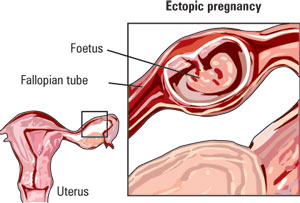For a couple expecting a baby, a diagnosis of an ectopic pregnancy can be heartbreaking. Implanted outside the uterus, the new embryo has no way of growing into a foetus. It also poses a serious threat to the mother’s life – and might require major surgery if not diagnosed early.
Still, this doesn’t rule out another successful pregnancy, says Consultant Obstetrician Dr. Nalinda Rodrigo. This week he speaks with Mediscene about early diagnosis, laparoscopic surgery and the risk of an ectopic pregnancy recurring.
Out of the womb
The pear-shaped human uterus is located inside the pelvis. Though it fulfils several key functions relating to sexual performance and even structural support for other organs, the uterus is best known as the womb - the home of a developing foetus.
In a normal conception, the egg is fertilized by sperm in the fallopian tube. The embryo which results from the union then travels through the tube and into the uterus, a journey which typically takes three to four days. But this process is hindered when a fallopian tube is blocked or damaged.
The embryo, unable to reach the safety of the womb, implants itself in the lining of the tube, resulting in an ectopic pregnancy. Ninety-five percent of ectopic pregnancies implant in the fallopian tube, but they can also occur in the cervix. Rarely, it will attach to an ovary or another organ in the abdomen.
None of these areas are designed to meet the demands of a growing embryo and after several weeks the tissues may rupture and cause major internal bleeding. Posing a serious threat to maternal health, such bleeding may require surgery.
Who is at risk?
Women who have abnormal fallopian tubes are at higher risk of ectopic pregnancy. Abnormal tubes are commonly the result of some kind of Pelvic inflammatory disease. Also known by the acronym PID, such conditions are categorized as infections of the uterus, fallopian tubes, and nearby pelvic structures.
Sexually transmitted diseases may also distort the tubes and slow the natural progress of the embryo. Tubal disease may also occur as a result of endometriosis and appendicitis or exposure to diethylstilbestrol (DES). Prior pelvic, abdominal or tubal surgery can also create scar tissue in the tubes. This may keep a fertilized egg from reaching the uterus. Once discovered, these embryos must be removed – the embryo cannot be transplanted into the uterus.
Sometimes there is no apparent explanation why an ectopic pregnancy has occurred. However, those who have already experienced an ectopic pregnancy are considered a part of the high risk group. They should be monitored carefully if they are attempting to conceive again.
Early warning signs
Missed periods, breast tenderness, nausea, vomiting, or frequent urination are among the early warning signs of an ectopic pregnancy. Since these mirror the signs of a normal pregnancy as well, expecting mothers might not initially suspect anything amiss. Some women may have no symptoms at all. They may not even know they are pregnant. The first real cause for concern then becomes pain or vaginal bleeding. Symptoms include:
- Abnormal vaginal bleeding or spotting: bleeding that is not a part of your normal menstrual cycle is called abnormal vaginal bleeding. It may be light or heavy.
- Shoulder pain: blood from the ruptured tissues can pool under the diaphragm, causing pain that is felt in the shoulder.
- Weakness, dizziness, or fainting: this can be triggered by blood loss.
- Low blood pressure: This is also caused by blood loss.
- Lower back pain.
Sometimes an ectopic pregnancy is suspected when an ultrasound does not show a pregnancy inside the uterus.
Diagnosis
A doctor may choose one of several methods when attempting to diagnose an ectopic pregnancy.
Human Chorionic Gonadotropin (hCG): In a normal pregnancy, the blood level of hCG, a hormone produced by the placenta, should double approximately every 48 hours. If this does not occur, it suggests a pregnancy which is not progressing as it should. Repeated measurements of hCG blood levels may be necessary before the correct diagnosis can be made.
Ultrasound Examination: Ultrasound can be used in the first three to five weeks after conception to determine whether or not a pregnancy is inside the uterine cavity. Ultrasound scans can also show fluid or blood in the abdominal cavity, suggesting bleeding from an ectopic pregnancy.
Laparoscopy: Sometimes a laparoscopy is required to confirm the diagnosis of an ectopic pregnancy. It can also be used to treat it. Requiring general anesthesia, this is an outpatient surgical procedure. A small telescope called a laparoscope is placed into the abdominal cavity through a small incision in the navel. If necessary, the doctor can usually remove the ectopic pregnancy by placing special instruments through the laparoscope or through small incisions above the pubic area.
Surgery
Laparotomy is usually reserved for those ectopic pregnancies that have ruptured, causing severe internal bleeding. An early diagnosis, made before any rupture in the tube, means a laparoscopic salpingostomy may be performed. Here the pregnancy tissue in the fallopian tube is removed, leaving the tube intact. It can be subsequently treated with medication so that it heals completely. A rupture, on the other hand, usually results in the removal of the tube.
Women who would like to attempt conception again will find that their remaining tube allows for this. But it also explains why one’s risk is increased – instead of the egg travelling through the tube that is closest to the ovary from which it is released, it must now make its way to the one remaining tube. This lengthened travel time makes an ectopic pregnancy more likely.
Conceiving again
In the end, ectopic pregnancy is both a physically and emotionally difficult experience. Upon the loss of the pregnancy, many women will feel a sense of grief or loss. Even though they could have done little to prevent it, self-blame, guilt, and depression are a natural part of this process. Women may also fear infertility. Still, it is a good idea from both a physical and emotional perspective to wait several months before attempting to conceive again.
Fortunately, at the end of their wait, would-be mothers can take comfort in the fact that almost all the women who had experienced an ectopic pregnancy will have a healthy pregnancy culminating in a normal birth.
|



